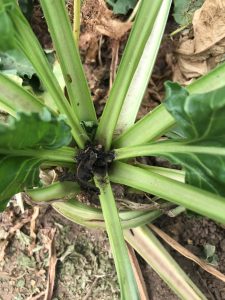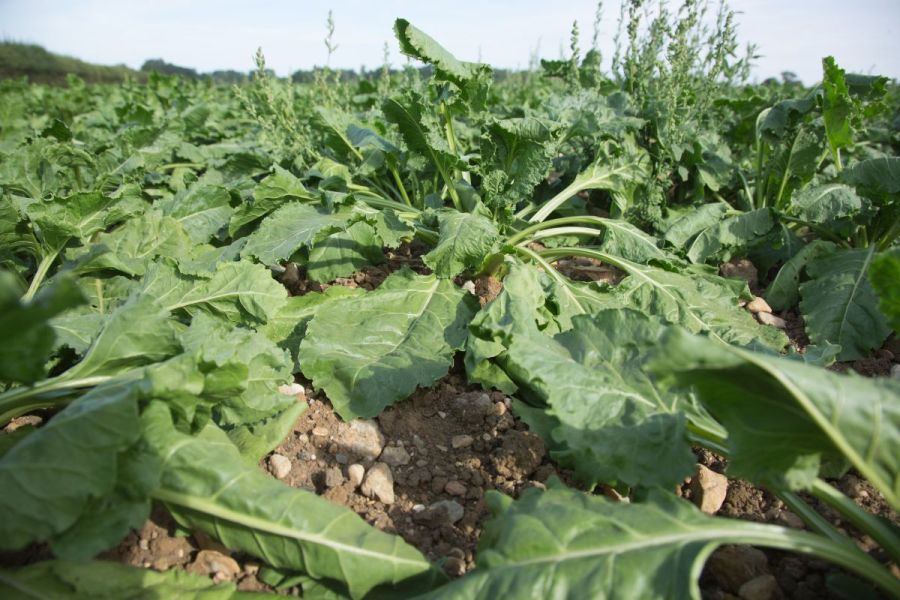During August BBRO introduced a new platform, BeetChat, which will offer a regular in-season webinar opportunity to quiz its team about current issues in the crop. CPM joins in to get an update on pests and diseases.
We probably haven’t had a season like this for many years with regard to the level of drought at the moment.
By Lucy de la Pasture
Sugar beet crops are rolling into the second heatwave of the summer, with temperatures forecast to be above 30⁰C for most of the week ahead. Hard on the heels of a period with little or no rainfall and precipitation for the year significantly below average, they’re enduring the drought with varying degrees of success.
“We’re almost in the middle of August and the challenges we’re being faced with are having a consequence particularly for disease control. Normally the first fungicide would have been applied by now, but that may not be the case at the moment – depending on location soil type – because many of us really haven’t have any rain in the last month,” says BBRO’s Prof Mark Stevens.

Drought conditions pose a particular problem when it comes to fungicide application and crops must be physiologically active to take up the fungicide, reminds Mark Stevens.
“Crops range from being pretty good and very resilient, to some really with very little leaf left. And that does have a consequence when it comes to trying to keep disease out, particularly as we think some of these crops may go right through to February. So there’s a need to try and look after that canopy to the best of our ability under the conditions that we have at the moment.”
Although the continental weather this summer hasn’t favoured all beet diseases, it has brought powdery mildew back into focus – a disease usually surpassed by rust in recent seasons.
“The disease we really have to keep an eye on and that may be the reason for applying a fungicide now, if you haven’t done so already, is powdery mildew. We knew that the powdery mildew forecast was relatively high at the beginning of the year, but conditions have been particularly conducive for its development,” says Mark.
“We’ve been seeing powdery mildew in BBRO trials and general walking through crops in the past 10 days and it’s increasing – the disease wasn’t difficult to find across the BeetField sites, particularly in the Peterborough area. So, it’s probably the one that you need to target because beet rust tends to like it slightly cooler with some leaf moisture – without that, it’s difficult for it to develop.”
Raising alarm bells in recent seasons has been cercospora, particularly in 2020 when it took advantage of virus-stressed beet crops. BBRO introduced an alert for growers last season which warns when conditions are conducive for cercospora development. But although there has been the odd uptick in risk level in some postcodes where there have been showers, Mark says cercospora is a disease that not only likes it hot, but it also likes moisture – something that’s in short supply at this stage in the season.
With powdery mildew the target, Mark says growers will potentially be looking at a broad-spectrum fungicide to try and keep on top of it. “At the moment, disease levels for other diseases are not of concern, although that can change over the coming days and weeks so broad-spectrum control is really important,” he adds.
Drought conditions pose a particular problem when it comes to fungicide application and Mark points out that crops must be physiologically active to take up the fungicide. With many crops wilting and with closed stomata during the heat of the day as they guard against excess evapotranspiration, that’s no easy task.
“I would emphasize that if you are going out to spray, first make sure you find disease before applying fungicides but also try and make sure you’ve got some turgid leaf tissue to apply it to. The plant should be physiologically active because otherwise you will not get the same level of control.
“Probably the best time to look at the crop is very early in the morning when potentially the crop has had a chance to bounce back a little bit,” he suggests. “But I do appreciate this year is particularly challenging and we probably haven’t had a season like this for many years with regard to the level of drought out there at the moment.”
Pest problems in Suffolk
Beet plants with blackened heart leaves have been causing the BBRO plant clinic to scratch heads over the past few weeks, says Mark. Initially, photos sent in looked like dried up downy mildew or the symptoms of boron deficiency but once plant samples were received, it became clear something else was at play.
“Knowing there was some downy mildew about six weeks ago, that was the initial diagnosis. However, in the past 10 days further reports have been received and samples have been coming into the plant clinic. And it’s become clear we seem to have gained a new pest, or one that was already here, that’s taken a liking to sugar beet under the dry conditions.

A new pest has emerged in Suffolk and is its larvae are damaging the heart leaves. BBRO are scrambling to identify what species it actually is.
“From the dissections we’ve been doing, it’s possibly beet moth or weevil larvae attacking the heart leaves, eating the petioles and taking out the growing point of plant.”
The precise species is yet to be confirmed but BBRO is consulting with entomologists to identify the culprit, says Mark.
We’re trying to pupate those out and get them to adults and we’re going to be sending some samples to a couple of entomology labs for them to cross diagnose to see what they come back with.”
Mark says these pests are likely to be a direct consequence of the warm dry weather and ultimately climate change, but he doesn’t believe it’s the beet weevil that’s been causing problems in other parts of Europe – particularly Austria, Poland and Southern Germany.
“I can never say never, but this damage has come very late in the season, whereas beet weevil damage in Europe tends to come in very early, when the crop is germinating.”
British Sugar’s Andrew Dear confirms that the damage from this pest has been found by its account managers in the Bury/Newmarket area in a corridor along the A14. BBRO is keen to establish whether its occurrence is more widespread, so urges growers and agronomists to report any unusual sightings in fields.
“It’s not like looking for aphids, this is a very easy pest to see once you get your eye in. It’s the larvae inside which are doing the direct damage – these are about two centimeters long, with a brown head with a dark band behind it. If you just split the petiole open, or take a penknife to pick into the heart, you’ll find them quite quickly,” explains Mark.
With 100% of plants affected in some fields, emergency control measures may be required but that isn’t a simple task.
“It does provide a slight headache because there aren’t really any products available at this stage to control weevils in the UK. We are aware of some of the approaches that are used in Europe, so we know that certain sprays that we do have in the UK will potentially have activity, but the label for UK conditions doesn’t extend to weevil,” he explains.
“Pyrethroids will be effective against beet moth larvae if required, but the worry is that pyrethroids won’t touch a weevil because we know weevils often are resistant. This is where we have to be careful and make sure we know what the problem is before any final decision is made to tackle it.”
Potato approval for DMN at last
It’s news that in the eyes of potato growers has been a very long coming, but CRD has at last granted GB authorisation for use of the sprout suppressant 1,4Sight (1,4-dimethylnapthalene or DMN) from DormFresh.
DMN was first discovered as a natural volatile given off by potatoes and is suitable for both the fresh and the processing sector, in all storage types and conditions, says Ajay Jima, Dormfresh technical manager.

DMN’s approval without restrictions means that growers will have an important new option in their toolbox for sprout control over a full storage season, says Ajay Jina.
“Its approval without restrictions means that growers will have an important new option in their toolbox for sprout control over a full storage season. This is an important step forward for the GB potato sector.”
“Applied as a hot fog, 1,4Sight doesn’t just burn off the sprouts, it will stop their formation and put tubers into a dormant state,” he explains. “This results in less weight loss during storage and potatoes come out of store looking almost the same as when they went in.”
First identified by Dr Harry Duncan, who discovered its stand-alone properties, DMN has been in commercial use since 1996. It’s currently approved in 23 European countries, the United States, Canada, Mexico, New Zealand and Brazil.
Ajay, who previously worked at Sutton Bridge Crop Storage Research (SBCSR), highlights that there is a wealth of independent data on the product having been trialled in the UK since 1999. “We also have a lot of experience with the product in commercial stores as it was approved for use in the Netherlands in 2015,” he comments.
“Feedback from our users show they have found 1,4Sight to have excellent efficacy as well as leaving tubers with a good skin bloom, and they have also reported a reduction in compression damage and bruising.”
This article was taken from the latest issue of CPM. For more articles like this, subscribe here.




